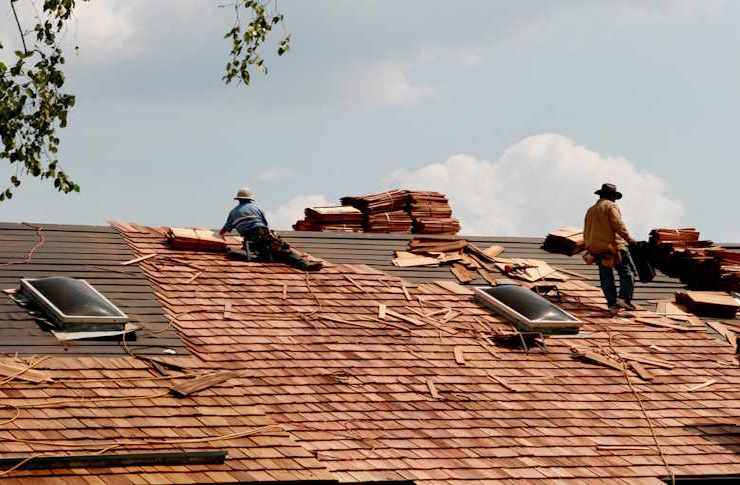roof covering
Roof covering represents the outermost layer of a roofing system that protects your home from weather elements. Selecting the right roof covering material is crucial for ensuring your home remains safe and structurally sound for years to come. Whether you're building a new home or replacing an existing roof, understanding different roof covering options, their benefits, and installation processes can help you make an informed decision. This article explores various roof covering materials, how to find qualified roofing companies in your area, and what to expect when getting quotes for roofing replacement.

Types of Roof Covering Materials
The material you choose for your roof covering significantly impacts your home’s appearance, durability, and energy efficiency. Asphalt shingles remain the most popular option in the United States, accounting for approximately 70-80% of residential roofs due to their affordability and easy installation. Metal roofing has gained popularity for its exceptional longevity (40-70 years) and energy efficiency. Clay and concrete tiles offer distinctive aesthetic appeal and excellent durability but require structural reinforcement due to their weight. Slate provides a premium, natural appearance and can last over 100 years, though it comes with a higher price tag. Wood shingles and shakes deliver a rustic, natural look but require regular maintenance to prevent moisture damage and fire concerns. Newer synthetic options like composite and rubber roofing mimic traditional materials while offering enhanced durability and sustainability benefits.
Finding Reliable Roofing Companies in Your Area
Locating trustworthy roofing professionals is essential for quality roof installation or replacement. Start by seeking recommendations from neighbors, friends, or family members who have recently completed roofing projects. Online review platforms like Google, Yelp, Angie’s List, and the Better Business Bureau provide insights into local roofing companies’ reputations and customer satisfaction ratings. Verify that any company you consider holds proper licensing and insurance, including workers’ compensation and liability coverage, to protect you from potential liability. Established companies with physical offices in your community often demonstrate greater accountability and accessibility. Finally, prioritize contractors who offer detailed written estimates, clear contracts, and strong warranties on both materials and workmanship.
What to Expect When Getting Quotes for Roofing Replacement
The quote process for roof replacement typically begins with a comprehensive roof inspection by the contractor. During this assessment, they’ll examine your current roof’s condition, including any damage or underlying issues that need addressing. A professional quote should include detailed information about materials, labor costs, removal of old roofing, disposal fees, and any necessary repairs to the roof deck or structure. Be wary of significantly lower quotes that might indicate subpar materials or incomplete service. Most reputable companies will provide a timeline for project completion and explain their payment schedule. Don’t hesitate to ask questions about warranty coverage, potential additional costs, and the contractor’s approach to unexpected issues discovered during the project.
Cost Factors for Roof Covering Projects
The price of a roof covering project varies significantly based on several key factors. Material choice represents one of the biggest cost variables—asphalt shingles typically range from $3.50-$5.50 per square foot installed, while premium materials like slate can cost $15-$30 per square foot or more. Roof complexity, including pitch, number of layers to be removed, and architectural features like dormers or skylights, increases labor costs. The total surface area of your roof naturally affects the overall project cost. Regional variations in labor costs and local building codes can also impact pricing. Most residential roof replacements fall between $5,000 and $25,000, with the national average around $8,500-$14,000 for a moderate-sized home with asphalt shingles.
| Roofing Material Type | Average Cost Per Square Foot (Installed) | Typical Lifespan | Maintenance Requirements |
|---|---|---|---|
| Asphalt Shingles | $3.50-$5.50 | 15-30 years | Low |
| Metal Roofing | $7.00-$14.00 | 40-70 years | Very Low |
| Clay/Concrete Tiles | $10.00-$18.00 | 50+ years | Low to Moderate |
| Wood Shingles/Shakes | $6.50-$14.00 | 20-40 years | High |
| Slate | $15.00-$30.00 | 75-100+ years | Low |
| Synthetic/Composite | $7.00-$13.00 | 30-50 years | Low |
Prices, rates, or cost estimates mentioned in this article are based on the latest available information but may change over time. Independent research is advised before making financial decisions.
Preparing for Your Roof Covering Installation
Before installation begins, proper preparation ensures a smoother process and better results. Clear your driveway and move vehicles to provide space for equipment and material delivery. Remove or secure valuable or fragile items inside your home, as the installation process creates vibrations that can knock objects from walls or shelves. Temporarily relocate sensitive outdoor items like potted plants, patio furniture, and grills. If you have pets, consider arrangements to keep them comfortable during the noisy installation process. Inform neighbors about the upcoming work, as it will create noise and possibly some debris. Finally, ensure clear access to electrical outlets for the roofing crew and verify that someone will be available to answer questions that might arise during installation.
Maintaining Your New Roof Covering
After investing in a new roof covering, regular maintenance helps maximize its lifespan and performance. Schedule professional inspections at least once yearly, particularly after severe weather events. Keep gutters and downspouts clear of debris to prevent water backup that can damage roofing materials. Trim overhanging branches that could scrape and damage the roof surface or deposit excessive debris. Address moss, algae, or mildew promptly using appropriate cleaning methods for your specific roofing material. Check attic ventilation regularly, as proper airflow prevents heat and moisture buildup that can deteriorate roofing materials from underneath. Finally, keep records of all maintenance, repairs, and warranty information for reference and potential future home sale advantages.
By understanding your roof covering options, finding qualified professionals, and maintaining your investment properly, you’ll ensure your home remains protected and attractive for years to come.




